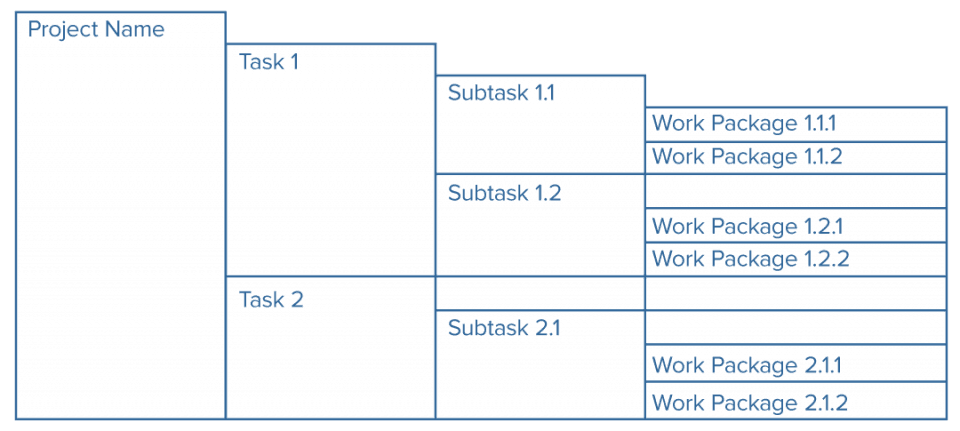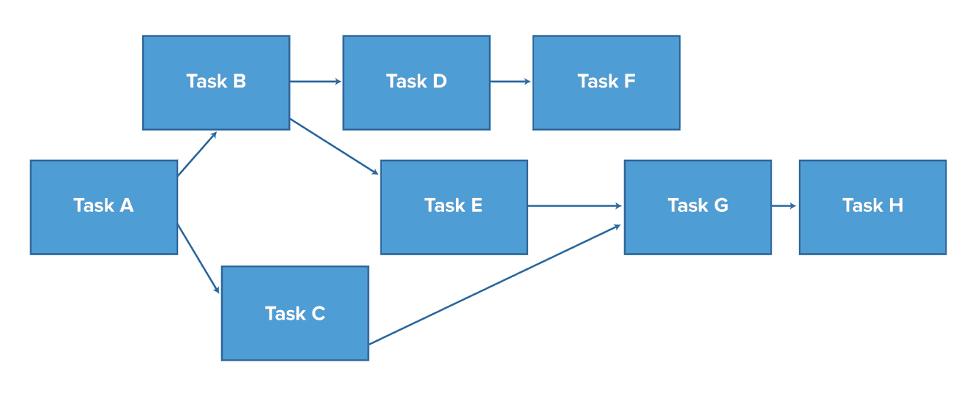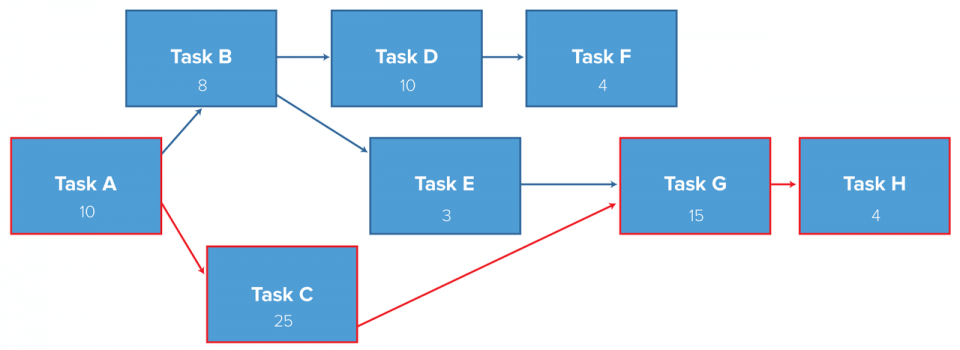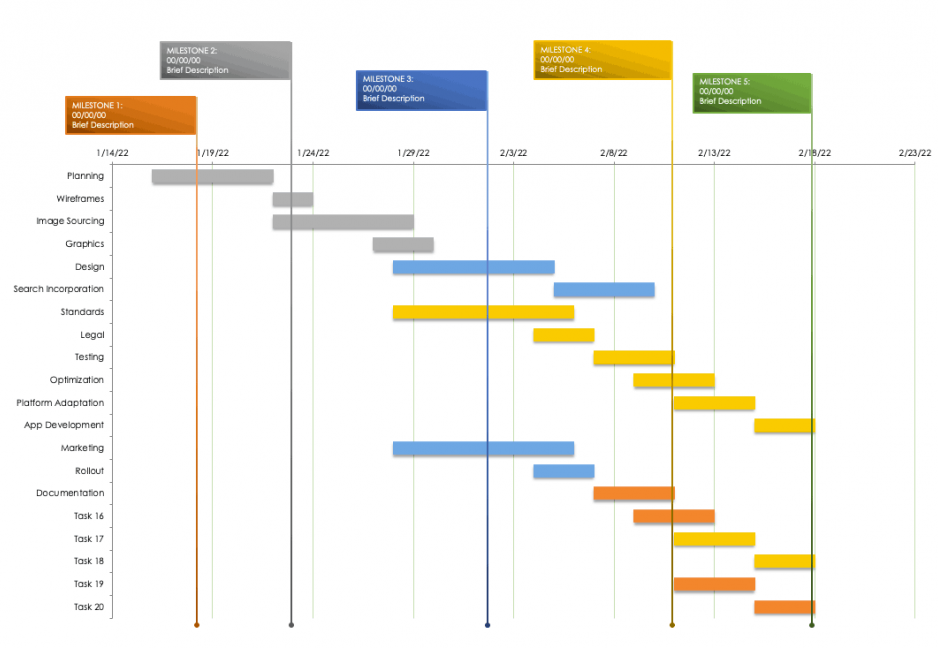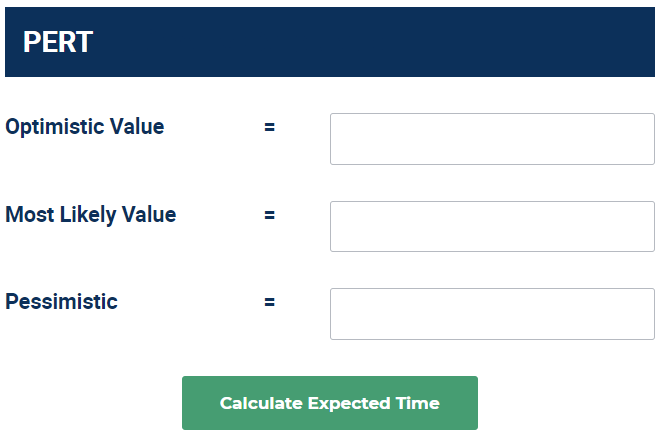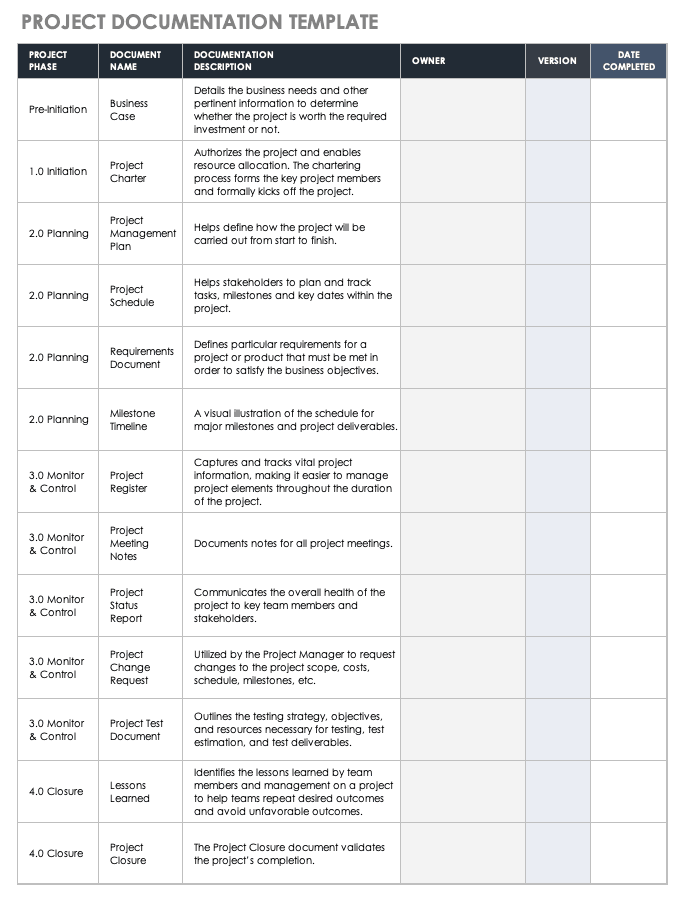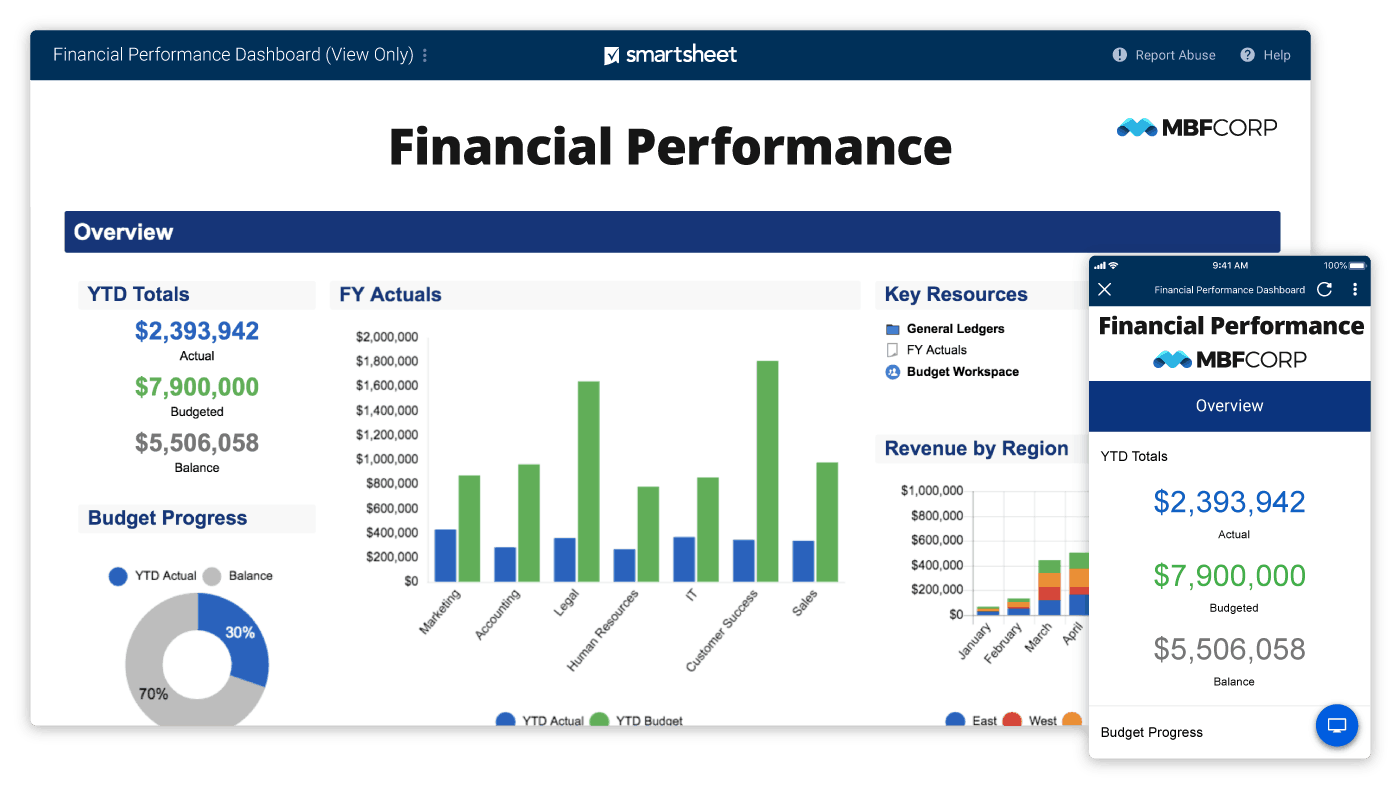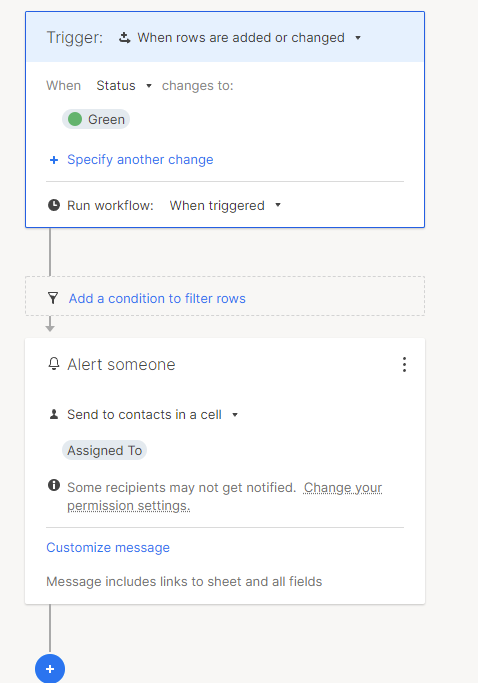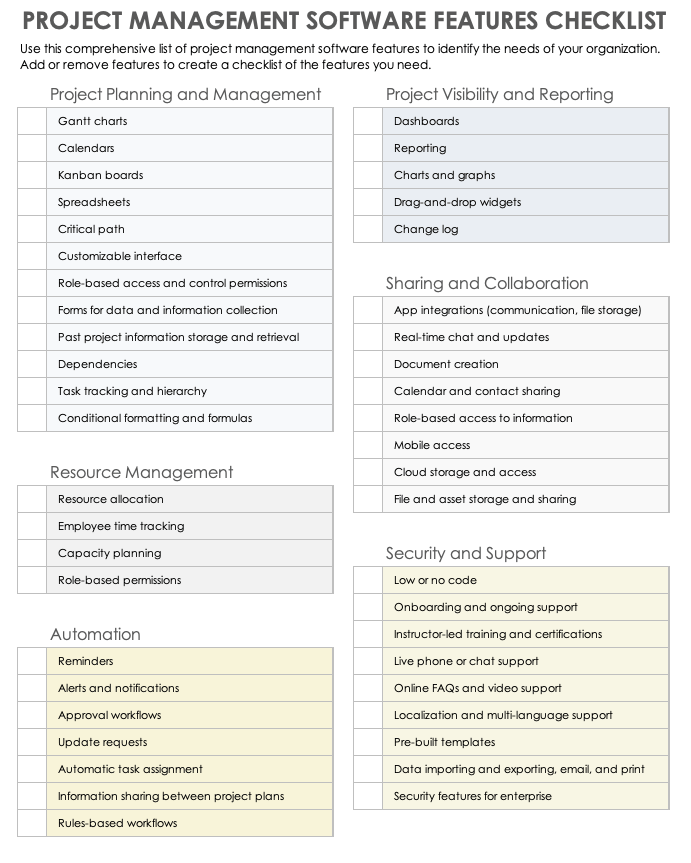What Is Project Management Software?
Project management software is a collection of tools that aid project managers by providing solutions for team-based communication, scheduling, deadline tracking, and document organization. Gantt charts, instant messengers, and shared calendars are examples of specific types of project management software.
Project management software typically refers to a suite of tools bundled together into one product. Each of these tools, however, can individually aid project managers. The advantage of a singular project management solution is that all of its tools integrate seamlessly.
What Does Project Management Software Do?
Project management software assists project managers in all phases of the project management process. It provides methods to easily communicate and collaborate with team members, track schedules and deadlines, organize documents, and send updates and notifications in real time.
Many project management programs bundle these solutions to provide a more unified experience. Project management software can aid in several management responsibilities, such as the following:
- Automation: Automation reduces time spent on simple, repetitive tasks. Project management software allows you to automate notifications, reminders, reports, and other more complicated processes.
- Communication: This includes tools such as instant messengers, notifications and reminders, real-time updates, and shared workspaces and dashboards.
- Information Sharing: Project management software usually offers role-based access so that project managers can share specific information with only the people who need it.
- Organization: Project management software can help you stay organized with cloud storage for project spreadsheets and other documents, as well as automatic report filing.
- Scheduling: This includes shared calendars, deadline tracking, and automatic updates and reminders.
Why Is Project Management Software Important?
Project management software reduces the amount of time wasted on repetitive, predictable tasks. Project managers can increase productivity and reduce human error for a project by automating their reporting, scheduling, and notification processes, instead of completing them manually.
Project management software is useful for businesses of any size in any industry. Most companies use multiple programs to solve their project management needs. The true utility, however, comes from finding one solution that integrates those features and packages them together.
“For my business, it's all about workflow,” says Peter Robert, CEO and Founder of Expert Computer Solutions (ECS). “Project management software is critical in maintaining a consistent workflow with my whole team. By using productivity features such as site blockers, task completion notifications, and document edit notifications, my team can stay on top of current project-wide developments and keep their workflow consistent.”
Cody Miles, CEO and Founder of Ashore, explains how project management software has improved his critical business processes. “Adopting project management software has transformed how we go about our review and approval for marketing materials, creative collateral, videos, and website revisions alike. Before implementing a project management system, the process was tedious and frustrating, and it took far longer than it needed to. Projects failed to meet deadlines, the feedback was unusable, and we found ourselves making far more rounds of revisions than necessary. With the addition of project management software, those issues have all but disappeared.”
Common Features of Project Management Software
Most project management software solutions offer similar features, such as real-time updates, shared documents and dashboards, and reporting. Understanding these features and how they work will help you determine which project management software is right for your team or organization.
Project Planning and Management
Project planning and management features allow you to visualize your project plans and track their status.
Some common project planning and management features of project management software include the following:
- Calendars: Project management software often integrates calendars that team members can share and edit.
- Conditional Formatting and Formulas: Use conditional formatting and formulas to create complex documents that are more helpful and easier to parse.
- Critical Path: Project management software can help to identify the critical path, an algorithm that helps managers prioritize and streamline tasks.
- Customizable Interface: Most software allows you to customize your interface so that you can easily access the updates and documents that are most important to you.
- Data Importing and Exporting: Project management software allows users to import data from existing sources and export data to other programs in multiple formats.
- Dependencies: Project management software provides an easy way to identify and track task dependencies.
- Forms for Data and Information Collection: Some project management software solutions allow you to create and send fillable forms to collect information or feedback from users.
- Gantt Charts, Kanban Boards, and Spreadsheets: Many project management software suites allow you to display your project data in multiple ways. Use Gantt charts to track task progress, Kanban boards to visualize next steps, and spreadsheets to gather and view project information.
- Past Project Information Storage and Retrieval: As a project manager, it is helpful to use previously successful projects as templates for future ones. Most project management software allows you to easily reference previous project information so you can make informed decisions on current projects.
- Role-Based Access and Control Permissions: Many project management software options allow you to permit or restrict access to information based on the role of the user. Choose who can view, edit, and share your documents by assigning roles to each team member. Some programs even allow you to grant access to non-users. “For my specific domain of web maintenance, guest accounts are a very important feature,” says Edward Fisher Jr., Owner of Fisher Tech Solutions. “Without them, I would need to read through many emails a day and create tickets for my employees to handle tasks on an ongoing basis. By using guest accounts, my clients can just sign into the software and create the tasks they need to be done for themselves.”
- Task Tracking and Hierarchy: Easily track task status and completion, and assign hierarchies to identify which tasks are most important.
Project Visibility and Reporting
Project visibility and reporting tools help project managers share their status and results with others.
Common project visibility and reporting features that you might look for in a project management software include the following:
- Change Log: Easily reference who makes updates and changes to project information, and when they entered those changes.
- Charts and Graphs: Create visual charts and graphs to display project data and make it easy to present and share.
- Dashboards: Dashboards are an easy way to provide real-time project status to anyone who needs it. Customize your dashboards to provide the most important project information at a glance. “With reports and dashboards, you should not only be able to tell if work is overdue, but see every action taken on the project, allowing you to better plan your time and resources in the future,” says Miles.
- Drag-and-Drop Widgets: Some project management solutions offer several types of drag-and-drop widgets to customize the look and presentation of information on dashboards and reports.
- Reporting: Project management software makes reporting easy by including tools for sharing project data in various and customizable ways.
Resource Management
Resource management features give project managers the tools to make the best use of their team and materials.
Below are some common resource management features of project management software:
- Capacity Planning: Manage the capacity of your highly skilled teams, and ensure their availability for current and upcoming projects.
- Employee Time Tracking: Track and manage the time that your team spends on individual tasks. “Time tracking is important to keep track of employee pay, but also to keep track of how much time we're devoting to each client and each type of task,” explains Fisher. “As a new business, it is helpful to see what future hires I may need to make based on the amount of time each type of task is taking.”
- Resource Allocation: Project management software allows you to track the availability of team members and other project resources.
- Scheduling: Set dates for deadlines, tasks, sprints, and projects. “Software scheduling is essential in keeping my team on track and honoring deadlines,” shares Robert. “Sometimes, especially during busier times of the year, even the most organized team members need some help with task management.”
Sharing and Collaboration
Sharing and collaboration features allow teams to work more easily with the people around them.
“Remote collaboration is a must, both within our team and with clients,” says Whitney Hill, Co-Founder of SnapADU. “We invested in project management software to allow for easy collaboration across jobs, employees, contractors, and clients. This system enables us to streamline our communications and keep all discussions tied to a specific project. Within that same system, our clients can make approvals, see their schedules, and pay invoices.”
Some additional sharing and collaboration features of project management software include the following:
- App Integration: Most project management software integrates with other frequently used apps. Look for software that can integrate with your communication, file storage, and planning apps.
- Calendar and Contact Sharing: Project management software allows you to easily create shared calendars and directories, with options to grant access to various team members.
- Cloud Storage and Access: Most modern project management softwares allow users to access their files and assets from anywhere in the world.
- Mobile Access: Many project management software options provide limited access to mobile users through a dedicated mobile application. Some allow full functionality to mobile users.
- Real-Time Chat and Updates: Most project management software features an internal chat or notification system to allow for easy communication between collaborators.
Automation
Project management software provides powerful features to automate frequent, repetitive tasks. “When notifications, reminders, and workflows are automatic, you’ll save quite a bit of time,” says Miles. “Ideally, once you set up your workflow, the process should practically run itself.”
Below are some common automation features in project management software:
- Alerts and Notifications: Automatically notify users when you make changes, or alert them when you’ve assigned new tasks.
- Approval Workflows: Approve requests automatically, or send them to the appropriate party when they do not meet your criteria for automatic approval.
- Automatic Task Assignment: Assign tasks to available team members as they arise.
- Connect Information Between Project Plans: Create and link project documents to automatically update one another when changes are made.
- Reminders: Set automatic reminders when deadlines are near.
- Rules-Based Workflows: Some project management software includes powerful rules-based workflows to automate more complex tasks.
- Update Requests: Set update requests to go out at regular intervals.
Security and Support
Modern project management software includes features that help teams keep sensitive information secure and that provide ongoing support to teams.
Some common security and support features for project management software include the following:
- Instructor-Led Training and Certifications: In addition to online FAQs, some project management software companies provide product training and certification led by live instructors.
- Live Phone or Chat Support: Modern project management software companies provide live phone or chat support to help users troubleshoot and solve problems as they occur.
- Localization and Multilanguage Support: Many project management software organizations provide localization and support in more than one language.
- Onboarding and Ongoing Support: Many project management software companies provide onboarding services and ongoing support to ensure that their users know how to fully utilize their products.
- Online FAQs and Video Support: Most companies provide a searchable database of text and video how-tos, as well as frequently asked questions, for users to find answers to common queries.
- Pre-Built Templates: Some companies provide custom, pre-built templates for common use cases to their customers.
- Security Features for Enterprise: Project management software companies provide security for storing and retrieving sensitive information.
- User-Friendly Interface: Most modern project management software do not require the user to be overly tech-savvy. Many software options feature an interface designed with user experience in mind.
Benefits of Project Management Software
Adopting project management software offers many benefits, such as increased productivity, better organization, improved communication, and more adherence to project management best practices. Review these potential benefits to see if project management software might address problems within your organization.
Some of the most significant benefits of adopting project management software include the following:
- Better Project Completion Rate: Project management software helps managers adhere to project management best practices, which can have tangible benefits. Companies that better adhere to project management best practices meet their project goals 21 percent more often than companies that don’t.
- Better Scalability: Project management software makes it easier to improve on the successes of past projects and fix mistakes. The longer you use the software, the simpler it becomes to organize larger and more complex projects.
“We find our PM software’s scheduling functionality to be indispensable because it allows us to template out our jobs, saving time when we start each new project,” Hill explains. “This schedule then serves as the backbone for other items and tasks in our system, effectively making our timing on payments, invoicing, and job to-dos dynamic based on job progress. Using this schedule at a detailed level also allows us to memorialize job shifts along with reasons for delays for broader analysis so we can manage performance over time.” - Improved Executive Buy-In: Project management software allows you to better organize and plan your projects, leading to better presentation of information and improved executive buy-in. The easier you can make it for executives to see the whole picture, the more likely they are to support you in your efforts.
- Improved Communication: Many project management software programs group together relevant conversations with the project information they reference. Instead of needing to sort through emails to find information, project management software allows you to keep all conversations in one place.
- Improved Morale: Employees want to feel productive. Project management software allows them to spend their time getting their work done rather than replying to emails and writing progress reports.
- Increased Productivity: Project management software allows teams to work more efficiently with automation, better visibility, and more streamlined processes. “Automation can improve business productivity tenfold by allowing your team to focus less on administration and IT, and more on actual business development,” says Robert.
- Increased Visibility: Project visibility allows all project stakeholders access to up-to-date information at all times. Visibility allows all team members and stakeholders to see who is working on what, when, and what the next steps are. “Shared calendars ensure every team member is on the same page regarding deadlines, and file sharing promotes more efficient and productive collaboration,” explains Robert.
- Reduced Costs: The adoption of project management software can save an organization large sums of money over its lifetime. Automation decreases operational and labor costs, and an improved ability to estimate project time frames means less time wasted overall.
- Simplified Organization: Most project management software uses cloud storage for easy organization and to allow access from anywhere. This software keeps project information together automatically, and team members can access from anywhere they can log in to the software.
Disadvantages of Project Management Software
While project management software offers many benefits, it also poses potential disadvantages. These drawbacks include upfront costs, time investment to research and establish processes, and a steep learning curve for you and your team.
Here are a few of the most common concerns for new project management software adopters below:
- Costs: Project management software can be an expensive initial investment. Many are also on a subscription model, so the price is ongoing over the life of the product. It is worth noting, however, that project management software will likely save money in reduced labor hours for digitized tasks in the long run. “Think about how many hours you could save by using software that speeds up your processes, and multiply that number of hours by the salary of your employees,” suggests Kyle Graynor, Senior Director of Performance Marketing for Pumpkin. This value adds up quickly, making project management software an easy choice for a lot of businesses.
- Learning Curve: Tech aptitude varies by person and by team. It can be difficult to convert manual processes to digital ones, but most project management software is well supported and created with user experience in mind.
“I’ve found the biggest hurdle to get people in your company to use the software is actually just how easy it is, not how many bells and whistles it has,” says Graynor. “If software is easy to use, it means that the less tech-savvy employees are much more likely to use it. If a few people don’t use the software, it can really make organization much harder for those using it, so this is a very important factor to keep in mind.” - Team and Executive Buy-In: Convincing people to change their behavior can be difficult, especially when the product is expensive and requires time to learn. Many software companies offer free trials that can be helpful for securing buy-in. Generate results to show executives, and allow your team to sample the software or suggest different software before you invest in a permanent solution.
- Time Investment: Digitizing your processes takes time. Assign one person to focus on converting manual processes to digital versions in order to streamline the process and avoid falling behind on projects. By doing so, you and the rest of the company can move forward on existing projects while a project management software champion works with the product’s support team to set up operations for an easy transition.
- Extensive Research: With the number of project management software solutions available, it can be overwhelming to research your options. If you are interested in learning more about how to choose the right project management software for your team, we’ve created a guide to take you through the process.
What Tools Does a Project Manager Use?
Project managers use many tools to aid in their work, from network diagrams that help with planning project tasks to Gantt charts that help with scheduling. When used correctly, these tools can improve efficiency, effectiveness, and overall organization.
Here are some of the most common tools and methodologies used by effective project managers:
- Automation Tools: Your project management software should allow you to automate deadline reminders and notifications using your schedules and Gantt charts.
- Critical Path Method (CPM): The critical path method is a project management methodology that outlines the path of the critical steps needed to complete a project. Project managers can visualize the critical path using tools like network diagrams and Gantt charts.
- Dashboards and Visualization Tools: Project management software allows you to create dashboards so that you can visualize project progress and communicate which step of the path or network diagram your team members are on. Dashboards are also useful for organizing project documents and keeping them in one place.
- Gantt Charts: A Gantt chart is a tool that marks the time needed to complete tasks within a project. A good project management software tool should allow users to create and edit Gantt charts to aid with scheduling and planning.
- Network Diagrams: A network diagram is a visual representation of a project’s steps based on the dependencies among those steps. Look for a project management tool that can create network diagrams that are as complex as you need.
- Project Documentation: Project documentation refers to all of the records created when planning a project. This includes records such as your project plan, charter, schedule, and closure.
- Program Evaluation and Review Technique (PERT): PERT is a project management technique that emphasizes the estimated completion time for tasks. This feature is useful when you do not know exactly how long a task will take to complete.
- Task Assignments and Deadline Trackers: Your tool should allow you to create network diagrams and track your projects using CPM, PERT, or WBS strategies. Use the software to create schedules and Gantt charts that help you organize and track this information.
- Work Breakdown Structure (WBS): WBS is a model that project managers use to break projects down into smaller components by category, in order to help plan projects and organize their teams.
Examples of Project Management Tools
With so many project management tools at your disposal, it can be difficult to know how each is used in practice and how they might benefit your project. We’ve compiled a list of common project management tools and methodologies, along with some helpful use cases.
- Work Breakdown Structure (WBS): Use the WBS methodology to map out project tasks and subtasks into digestible deliverables. By doing so, you’ll create an outline of a project that can be used to build a schedule and assign teams to specific tasks.
- Network Diagrams: A network diagram is a map of every task, along with its dependencies, involved in a project. This planning tool provides a helpful framework for visualizing all of a project’s branching paths.
- Critical Path Method (CPM): When using the critical path method, project managers chart the most efficient route through a network diagram to complete a project. In this example, the critical path excludes four tasks that are unnecessary for project completion and can therefore be deprioritized.
- Gantt Charts: Gantt charts are a great way to map out a team’s estimated and ongoing workload throughout the course of a project. In this example, each task is highlighted by color and is mapped out by its estimated start and end date.
- Program Evaluation and Review Technique (PERT): PERT is a scheduling tool that project managers use to give a realistic estimation of the time needed to complete a task. For more information on PERT and access to a free PERT calculator, see this comprehensive guide to PERT.
- Project Documentation: Properly documenting project information allows project managers to refer back to important details that can inform future decisions and help ensure project success. Use this project documentation template to organize all of the documents used to complete a project, identify who is responsible for them, and assign a completion date for each.
- Dashboards: Dashboards are useful for sharing high-level information at a glance. The information reported on a dashboard can be customized based on what the project is and who is viewing it.
- Automation: Use automated workflows to simplify predictable, repetitive tasks. In this example, the workflow will automatically notify the team member assigned to a task as soon as the status is changed to green.
Project Management Software Features Checklist
Download Project Management Software Features Checklist
Microsoft Word | Google Docs
We’ve created a comprehensive checklist of the features included in project management software. These software features can be divided into six categories: project planning and management, project visibility and reporting, resource management, sharing and collaboration, automation, and security and support.
Use this list to reference all of the helpful features project management software can offer your organization. Add, remove, or check off items to help decide what features your team needs or to compare different project management software options.
How to Build the Business Case for Buying Project Management Software
Once you understand the value that project management software can add to your organization, you’ll need to secure executive buy-in. Below, find information on how to build a business case for buying software and present it to your executive team.
“The best way to build a case for purchasing project management software is to track the amount of redundant or unnecessary tasks your team has to complete without them,” says Fisher. Choose one or two of your manual workflows and estimate the time you can save by automating all or even part of them.
These are some additional ways to ensure you get the best reaction from your executive team:
- Get Your Team on Board: Gather opinions and feedback from team members on features, and use the product with them first so you can show your executive team together.
- Research Your Options: Research project management solutions to find the best fit for your organization.
- Schedule a Demo: Reach out to sales representatives and start a conversation. See if they have any tools or presentations they can share, or if they offer free trials.
- Schedule a Meeting: When you have data to show your executive team, schedule a meeting to talk about the advantages of project management software. Come prepared to show the usage data you have compiled, as well as how much the software costs compared with the amount of time and money it might save the company in the long run.
- Utilize Free Trials: Take advantage of free tiers and trials to get a feel for how the software works with your existing processes. However, Hill also notes that “free options of project management software are often designed to give just a taste of the functionality, with many of the most powerful workflow features and integrations locked.”
“When building a business case for purchasing project management software, it's crucial to outline the challenges the software will help the company overcome and what impact that will have on the business,” explains Hill. “When defining the challenges, try to add quantifiable costs associated with the time being spent operating without the proposed solution. For example, can you estimate how many hours per project, and consequently per year, are being spent handling manual process flows? Or can you demonstrate a significant qualitative challenge, such as waning customer retention rates, that can be attributed to a poor project management system?
“Additionally, it may be possible to outline the competitive landscape, showing the table stakes for operating in your space. It may be the case that your customer or vendor base expects a level of interaction only possible with a robust project management system,” Hill concludes.
Find the Best Project Management Software and Tools with Smartsheet
From simple task management and project planning to complex resource and portfolio management, Smartsheet helps you improve collaboration and increase work velocity -- empowering you to get more done. The Smartsheet platform makes it easy to plan, capture, manage, and report on work from anywhere, helping your team be more effective and get more done. Report on key metrics and get real-time visibility into work as it happens with roll-up reports, dashboards, and automated workflows built to keep your team connected and informed. When teams have clarity into the work getting done, there’s no telling how much more they can accomplish in the same amount of time. Try Smartsheet for free, today.





